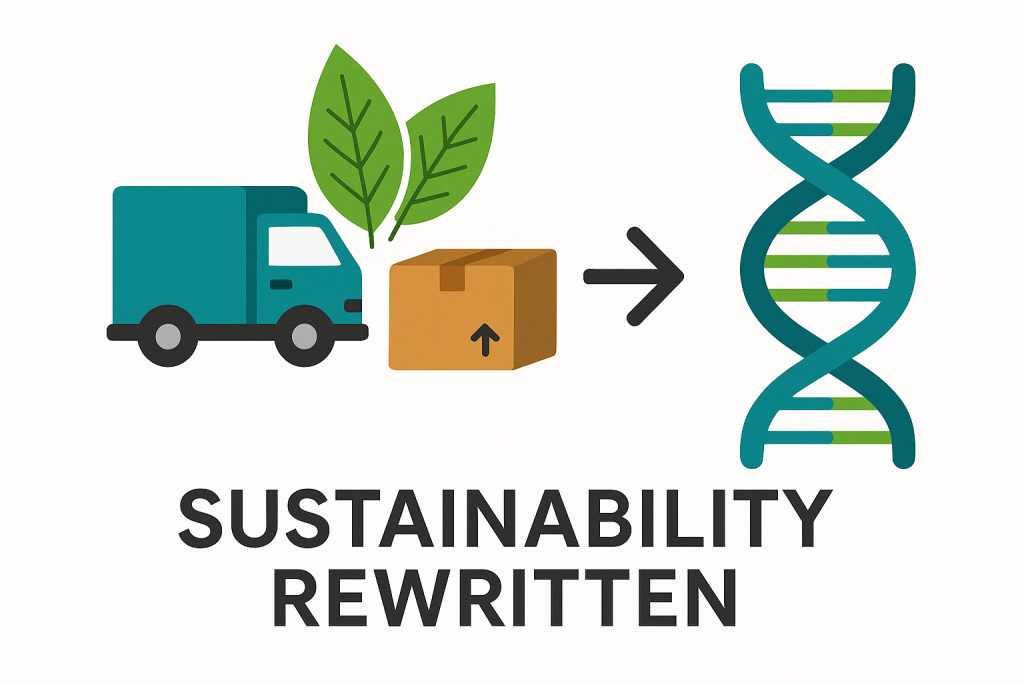The next industrial revolution won’t burn carbon—it will breathe it.
The Problem with Fossil Manufacturing
For more than a century, manufacturing has been tied to fossil fuels. Nearly everything—from plastics to fertilizers to construction materials—traces back to petroleum. These systems were designed for speed and scale, not sustainability.
The result: industrial processes now account for over one-third of global CO₂ emissions, driven by extraction, energy-intensive production, and chemical waste. Even as we electrify transportation and energy, the core materials economy still depends on fossil carbon.
Breaking that dependency requires a fundamental redesign—not of machines, but of biology.
CRISPR: The Blueprint for a New Industrial Age
CRISPR, the gene-editing technology that allows scientists to modify DNA with precision, has become the central tool in a growing movement called programmable biology. Instead of using crude oil as the feedstock of industry, researchers are teaching microbes to use carbon dioxide and sunlight as their raw materials.
These engineered organisms act as living factories—absorbing CO₂, converting it into sugars, fuels, and building compounds, and doing so at ambient temperature and pressure. The result is a form of production that’s self-renewing, carbon-negative, and decentralized.
Turning CO₂ into Commodity
CRISPR-edited microbes are already being tested to produce industrial essentials once thought inseparable from fossil resources.
- Fuels: Photosynthetic bacteria can now turn sunlight and CO₂ into liquid hydrocarbons suitable for jet fuel.
- Fertilizers: Engineered microbes fix nitrogen directly from the air, eliminating the need for energy-intensive ammonia production.
- Construction Materials: Bio-mineralizing bacteria can grow limestone or cement-like materials by trapping carbon in solid form.
Each breakthrough reduces both carbon emissions and dependency on extractive industries, turning pollution itself into a productive resource.
Why Biology Beats Chemistry
Traditional manufacturing relies on brute force—extreme heat, pressure, and chemical solvents—to transform raw materials. Biology takes a subtler approach: molecular precision.
Where petrochemical processes emit CO₂ as waste, CRISPR-based systems use it as an input. Where industrial chemistry demands high energy, biology works efficiently under natural conditions.
In short:
- Energy: Biology runs at room temperature, powered by sunlight.
- Feedstock: Biology uses waste carbon instead of virgin materials.
- Output: Biology produces biodegradable or recyclable compounds.
These efficiencies make programmable biology not just a cleaner option—but a smarter, lower-cost one as systems mature.
Factories that Grow, Not Pollute
Imagine a factory where rows of bioreactors replace smokestacks, each filled with engineered algae converting CO₂ from nearby power plants into fuels or polymers.
These “living factories” already exist in pilot form. Unlike traditional refineries, they produce oxygen instead of carbon emissions and can be replicated anywhere with access to sunlight and water.
In the long run, this model could replace the centralized, fossil-based infrastructure of the past with distributed networks of biological production, each customized for local resources and climate conditions.
A Climate-Positive Supply Chain
The climate advantage of CRISPR-based manufacturing goes beyond reducing emissions—it can reverse them.
When microbes capture CO₂ to make useful materials, that carbon remains stored until the material biodegrades or is reused. In effect, every ton of product removes a measurable amount of greenhouse gas from the atmosphere.
A recent estimate from emerging bioindustrial projects suggests that widespread biological manufacturing could offset up to 10% of global industrial emissions within two decades, while producing goods essential to the modern economy.
Educational Implications: Teaching the Biology of Industry
For educators and parents, this transformation is more than a scientific milestone—it’s a new educational framework.
Students growing up in this century will need to understand manufacturing as a biological process, not just an industrial one. Tomorrow’s engineers will design metabolic pathways, not assembly lines.
This shift demands literacy across disciplines:
- Biotechnology: how CRISPR reshapes metabolism for useful outputs.
- Systems thinking: how local biological systems can replace global extractive supply chains.
- Ethics: how to manage living technologies responsibly.
In classrooms, “sustainability” will move from theory to application—the study of how life itself can power civilization.
Ethics and Oversight
Reprogramming nature to serve industry raises important questions:
- How do we ensure engineered organisms remain contained?
- Who owns the genetic code for these biological processes?
- How do we measure and verify carbon capture in living systems?
Ethical design and governance must evolve alongside innovation, ensuring that biological manufacturing enhances rather than exploits ecosystems.
A Regenerative Industrial Future
CRISPR is giving us the tools to do something extraordinary: not just slow climate change, but reverse it through intelligent design. By teaching cells to build rather than destroy, we can replace fossil infrastructure with living systems that clean as they create.
This is nature’s factory reset—a complete rewrite of how we make things, where every product, process, and material becomes part of the planet’s recovery rather than its decline.
In this new industrial era, the most powerful machines on Earth won’t be engines or reactors.
They’ll be cells—coded to sustain life instead of consuming it.


